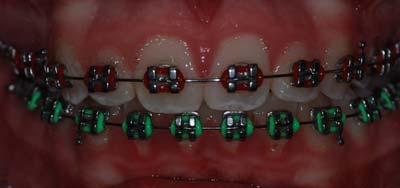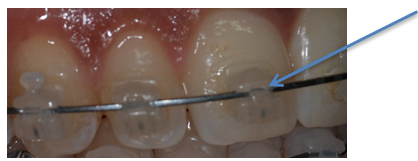Written by Dr. Chaw Su Kyi on January 29, 2015
Modern orthodontic treatment as we now know, has advanced over time to allow precise control over teeth, which results in being able to achieve excellent results.
The fixed part of the brace is the bracket which is attached to each tooth individually. There is a wire which connects all the brackets together and is held in place to the bracket by very small ‘elastics’.

The attachment of the wire onto the bracket is often a small ‘elastic’. They can come in different colours but serve the purpose of holding the wire in place, to allow the wire to work to allow tooth movement.
Some types of fixed braces have removed the need for this ‘elastic tie’ and are called self-ligating braces. Damon braces are a type of self-ligating braces. In some cases, self-ligating braces work very efficiently in straightening the teeth, allowing easier movement of the teeth.
Damon self-ligating braces do not need elastic ties to hold the wire in place, there is a ‘gate’ on the actual bracket. The orthodontist will open and close the gate to place the wire.
 “Gate”
“Gate”
One of the big advantages of Damon braces, by not having ‘elastics’ means there is less plaque build-up and easier to keep clean. ‘Elastics’ will always retain more plaque as it is an additional ‘layer’ around the bracket.
Damon braces also allow the teeth to move gently from the start. This is because the ‘gate’ on the Damon brace does not hold the wire in very tight as the ‘elastic’ would. If you think of a normal elastic rubber band – when you use it – it is taut and will hold an item together tightly, however, if you were to place the item in a container, it would still be held together but there will be space for the item to move around. The Damon brace is similar to the container allowing space for the wire to move but still holding it in place.
This ability to allow this type of movement, means that for you, the Damon brace will be working efficiently for longer, therefore your regular adjustment appointments can be every 8-9 weeks rather than 4-6 weeks. This would mean less disruption to your normal daily routines. Damon braces are also easier to maintain and keep clean. There are some cases where treatment is a little quicker and your time wearing braces can be reduced.
Each individual case needs to be assessed to ensure the correct brace is fitted. There will be cases where Damon braces are suitable and other cases where a more standard brace would be better suited. This is why it is essential a specialist orthodontist who fully understands all the different treatment and brace options assess you. Your face, mouth and teeth are unique to you and the way your teeth are moved and corrected has to be unique for you.